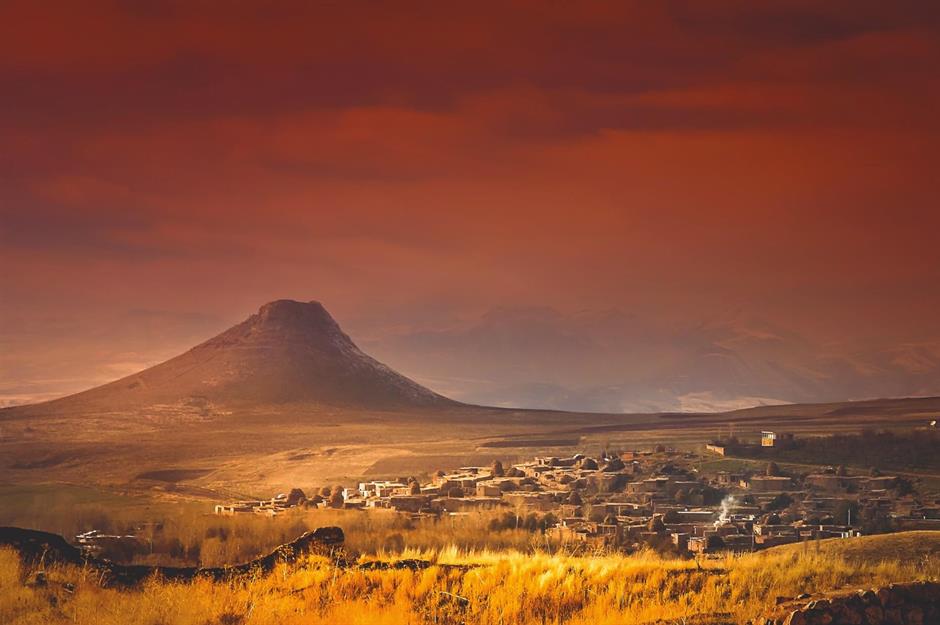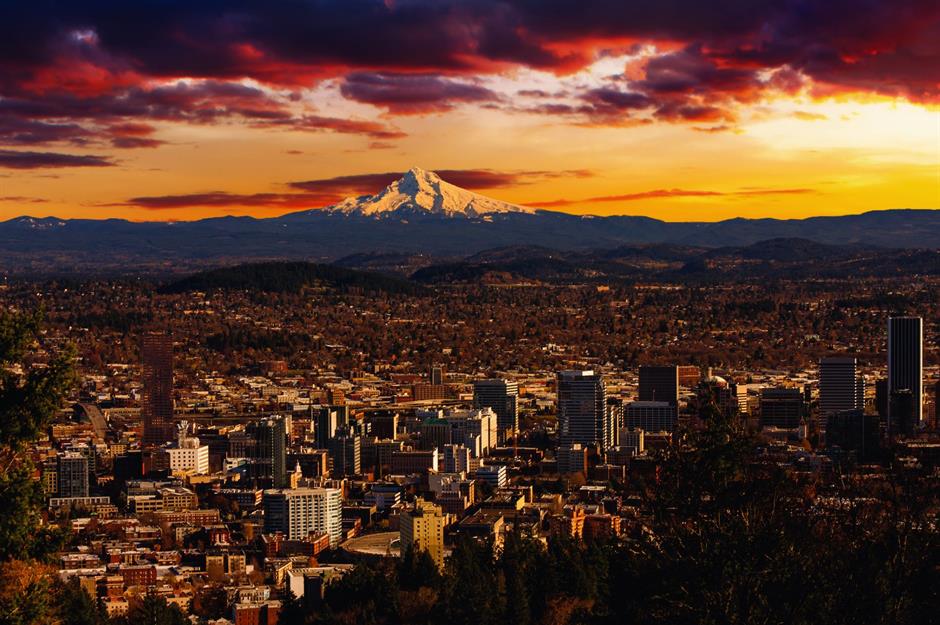The world’s beautiful and terrifying volcanoes captured on camera
Vivid volcanoes
From picturesque lake filled calderas to explosive rocky mountains, volcanoes are some of the most incredible yet deadly geological features on Earth. With the help of new book Volcano by Robert J. Ford, here we take a look at some of the most spectacular volcanoes around the world alongside some fascinating facts.
Mount Hood, Oregon, USA
Soaring high above Portland, Oregon’s largest city, Mount Hood is a cone-shaped stratovolcano, which means it's formed by layered lava flows and eruption deposits. The volcano hosts 12 glaciers along its upper flanks which, due to global warming, have drastically reduced in size over the past century. With its steep slopes and snowy terrain, Mount Hood is one of the largest and most popular ski destinations in the state.
Tolbachik, Kamchatka Peninsula, Russia
Tolbachik, Kamchatka Peninsula, Russia
Tolbachik, Kamchatka Peninsula, Russia
Tolbachik, Kamchatka Peninsula, Russia
Lava continued to flow and ash clouds hung in the air around the volcano for a total of 10 months before coming to an end in September 2013. The lava and ash destroyed a volcano observatory and various other structures and was thought to be the largest historical basaltic eruption in Kamchatka.
Love this? Follow our Facebook page for more travel features, news and inspiration
Cotopaxi, Cotopaxi province, Ecuador
Piton de la Fournaise, Réunion Island, Indian Ocean
Mount Ararat, Turkey
Mount Merapi destruction, Java, Indonesia
Between October and November in 2010, Indonesia’s most active volcano Mount Merapi had a series of dramatic eruptions that devastated the island of Java. The deadly volcano spewed toxic ash clouds and lava which swept across the landscape, killing at least 353 people and leaving hundreds injured. In this picture, Mount Merapi’s fallen ash has blanketed the city of Yogyakarta, making it look like an eerie ghost town.
Mount Merapi destruction, Java, Indonesia
Mount Nyiragongo, Virunga National Park, the Democratic Republic of the Congo
Misti, Arequipa, Peru
Mount Etna, Sicily, Italy
In this image, a smoking Mount Etna looms over the magnificent ruins of Teatro Antico di Taormina, an ancient Greek theatre on the Italian island of Sicily. The highest volcano in Europe, Mount Etna features two volcanoes, a shield volcano that began erupting here around 500,000 years ago and a stratovolcano that began forming around 35,000 years ago. With its dramatic eruptions, fiery lava flows and incredible geology, Mount Etna is one of the most impressive active volcanoes in the world.
Lagoa de Santiago, Sete Cidades, São Miguel Island, Azores, Portugal
This bright green lake in Portugal, known as Lagoa de Santiago, fills one of the cones of the Sete Cidades Massif, an ancient stratovolcanic complex on the western edge of São Miguel Island. The caldera is also home to the twin lake Lagoa das Sete Cidades. According to legend the lakes were created by the tears of two young lovers, a princess and a shepherd boy who were forbidden to see each other by the king. The princess’ blue tears filled the northern lake while the boy’s green tears filled the smaller lake.
Mount Damavand, Iran
Volcanic lakes of Mount Tongariro, Tongariro National Park, North Island, New Zealand
Famed for its breathtaking natural beauty, Mount Tongariro and its neighbouring volcanoes are the crown jewels of New Zealand's oldest national park. The volcanoes form part of the volcanic centre in the Taupo Volcanic Zone which has been active for two million years. Pictured here is one of the mountain’s volcanic lakes, its magical colours set against the dark rocky landscape draw sightseers from across the globe.
Devils Tower, Wyoming, USA
Piercing the prairie surrounding the Black Hills in Wyoming, this striking geological feature is considered sacred by indigenous American tribes. Rising 1,267 feet (386m) above the Belle Fourche River, the Tower is thought to have been below the Earth’s surface until erosion stripped away the sedimentary rock. Devils Tower rose to fame after starring in Steven Spielberg’s film Close Encounters of the Third Kind.
Bárðarbunga volcanic system, Vatnajökull National Park, Iceland
Iceland’s second-highest mountain, Bárðarbunga lies under the Vatnajökull ice cap, the biggest ice cap in the country. During the 2014–2015 eruption, the stratovolcano emitted millions of tonnes of sulphur dioxide which spread across Iceland, the Atlantic Ocean and towards Europe as well as a high volume of lava. The six-month-long eruption was the largest in the country since the 18th century.
Check out these stunning pictures of Europe’s best national parks
Puyehue-Cordón Caulle, Ranco province, Chile
Located in the south of Chile in the Ranco province, Puyehue-Cordón Caulle is a complex of two volcanoes, Puyehue and the fissure system of Cordón Caulle. After 51 years of inactivity, in 2011–2012, the volcano dramatically exploded in what has been described as one of the largest eruptions of the 21st century so far. Millions of tonnes of ash, sand and pumice were estimated to have been produced by the eruption, drifting across the globe, reaching other countries including South Africa, Australia and New Zealand.
Ol Doinyo Lengai, Tanzania
Mount Ruapehu, Tongariro National Park, North Island, New Zealand
Pictured here in New Zealand’s Tongariro National Park, is Mount Ruapehu, one of the most active volcanoes in the world. The most devastating eruption occurred in 1945, which caused a volcanic and ash barrier to form at its crater rim. On 24 December 1953, this crater burst, triggering mudflow and water which killed 151 people on a railway bridge in Tangiwai. Mount Ruapehu is best known for its crater lake, a breathtakingly beautiful pocket of acidic water.
Mount Ruapehu, Tongariro National Park, North Island, New Zealand
With its dramatic volcanic slopes and spectacular rock formations, Mount Ruapehu was used as a filming location for the fictional Mordor in Peter Jackson’s The Lord of the Rings.
Kelimutu, Flores, Indonesia
Hailed for its beautiful colour-changing lakes, the Kelimutu volcano lies within central Flores in Indonesia. Kelimutu’s enchanting lake phenomenon is thought to be caused by different minerals in the water alongside the balance between rainfall and gas input from the volcano.
Mount St Helens, Washington, USA
Mount Vesuvius, Campania, Italy
Probably the most famous volcano in history, Mount Vesuvius rises above the Bay of Naples in Italy. Vesuvius is best known for its devastating eruption in AD 79, which buried several Roman cities including Pompeii in a thick layer of ash. Today, with various settlements lying within its reach and it being the only mainland European volcano to have erupted in the past 100 years, Mount Vesuvius continues to be one of the most dangerous volcanoes in the world.
Check out these fabulous photos of fascinating Roman ruins around the world
Turrialba, Turrialba Volcano National Park, Costa Rica
Anak Krakatoa, Krakatoa Archipelago, Sunda Strait, Indonesia
Koryaksky, Kamchatka Peninsula, Russia
Mount Shasta, California, USA
Looming an impressive 14,179 feet (4,322m) high, Mount Shasta crowns the southern end of the Cascade Range, a chain of mountains running from British Columbia to Northern California. Shrouded in myths and legends, it’s thought that a secret city hides beneath the volcano’s double peaks. With its beautiful mountain scenery set against a turquoise blue sky, Mount Shasta is a popular landmark of northern California.
Erta Ale, Afar Depression, Ethiopia
This large active basaltic shield volcano in Ethiopia can be found within a sunken area of land known as the Afar Depression. The sunken land is caused by the junction of three diverging tectonic plates, the Arabian, Nubian and Somalian. The two latter plates form part of the African plate which is fracturing along the East African Rift and is also responsible for the volcano's lava supply. Erta Ale is famed for often hosting one or two active lava lakes and is one of the only volcanoes in the world with this unusual feature.
Mount Rinjani, Lombok, Indonesia
Teide, Tenerife, Canary Islands, Spain
Diamond Head, Oahu, Hawaiian Islands, USA
Fuego, Antigua, Guatemala
Zendān-e Soleymān, West Azerbaijan province, Iran
Find out more
All images were taken with permission from the book Volcano by Robert J. Ford, published by Amber Books Ltd and available via Amazon.

